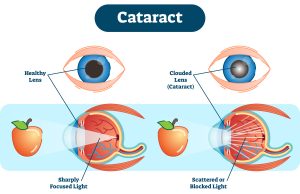
Cataracts are extremely common. In fact, the majority of those over 65 have some cataract development. If you have been told you have cataracts, DO NOT be alarmed. The word “cataract” comes from the Greek word “Cataracti” which means waterfall. The lens can appear to look like a bit like a waterfall when the cataract is quite advanced.
What is a cataract?
A cataract simply refers to ‘opacity of the lens’ inside the eye. Looking through a cataract can be thought of as a little bit like looking through an old stained piece of glass – instead of a clear new sheet. There are many different types of cataract. Not all cataracts cause symptoms. If a cataract causes no symptoms, it can usually be left alone. If symptoms such as blurred vision occur, then cataracts can be treated very successfully with surgery.
What is The Lens?
The lens of the eye is a transparent body located behind the iris (the coloured part of the eye). The lens is able to change shape, and in doing so, is able to accommodate to keep things focused on the retina at the back of the eye.
What are the causes of a cataract?
Cataracts are commonest in older people. However, they can occur at any age. Some children are born with cataracts (congenital cataracts). Cataracts are associated with the sun – and so are far more common in areas of the world such as India & Africa. Other causes include injury, diabetes, certain drugs, and some ocular diseases.
What are the common symptoms of cataracts?
For most people, the main complaint is some deterioration in the quality of vision. Most people usually feel they just need another sight test to get their glasses updated. Sometimes, people can complain of a ‘shadow’ behind objects they are looking at. Certain types of cataract can cause glare in bright light conditions. Because cataracts normally develop very slowly, over many years, most people don’t notice the gradual deterioration in their vision until it starts to interfere with daily activity or indeed, it is spotted by their optician.
How Are Cataracts Treated?
The most effective treatment for cataracts is an operation to remove the cataract, and replace the cloudy lens with a clear artificial lens implant. The lens of each eye should be clear in order for your eyes to work properly. The clear lens allows light to reach the retina at the back of the eye, which enables you to see things. With a cataract, less light can reach the retina, so your vision is affected. A cataract can be present for a while before you notice you have one. If you have a cataract, it will continue to develop. When spectacles can no longer improve your vision, the only way to restore your vision is by having the cataract removed by surgery.
The cataract operation
Cataract surgery is one of the most common and quickest type of ocular surgery performed today. Modern cataract surgery (called phacoemulsification) is usually performed under local anaesthetic as a day case procedure. During the surgery, a tiny incision is made into the eye and the lens removed with an ultra-sound probe. The capsule of the lens is left behind and this is used to house the new lens implant. The whole procedure takes between 15 and 20 minutes and the visual recovery is very quick with most patients noticing improved vision within a matter of days.
Lens Implant Types
Each patient and each eye is different. Measurements are taken prior to surgery (called biometry) to establish the correct lens power for the individual eye. Lens implants also come in different types. The two major categories of lens implant are:
Monofocal lenses –
(The vast majority of patients have this lens type put in)- These provide good distance vision but glasses are required for close work.
Multifocal lenses –
These intraocular lenses offer a high probability of achieving spectacle independence i.e. providing patients with the ability to see far as well as to read without glasses. Multifocal lenses have been shown to offer a high chance of reducing dependence on glasses for near and middle distance vision. However, patients can experience a reduction in contrast sensitivity (especially in dim lighting), as well as halos and glare around lights at night. Some patients are prepared to accept these visual effects because they are very keen to reduce their reliance on glasses. The pre-operative preparations for patients interested in multifocal lens implants are more involved than when monofocal lenses are being used, a wider range of issues needs to be discussed and the post-operative management is more intensive.





POST REPLY